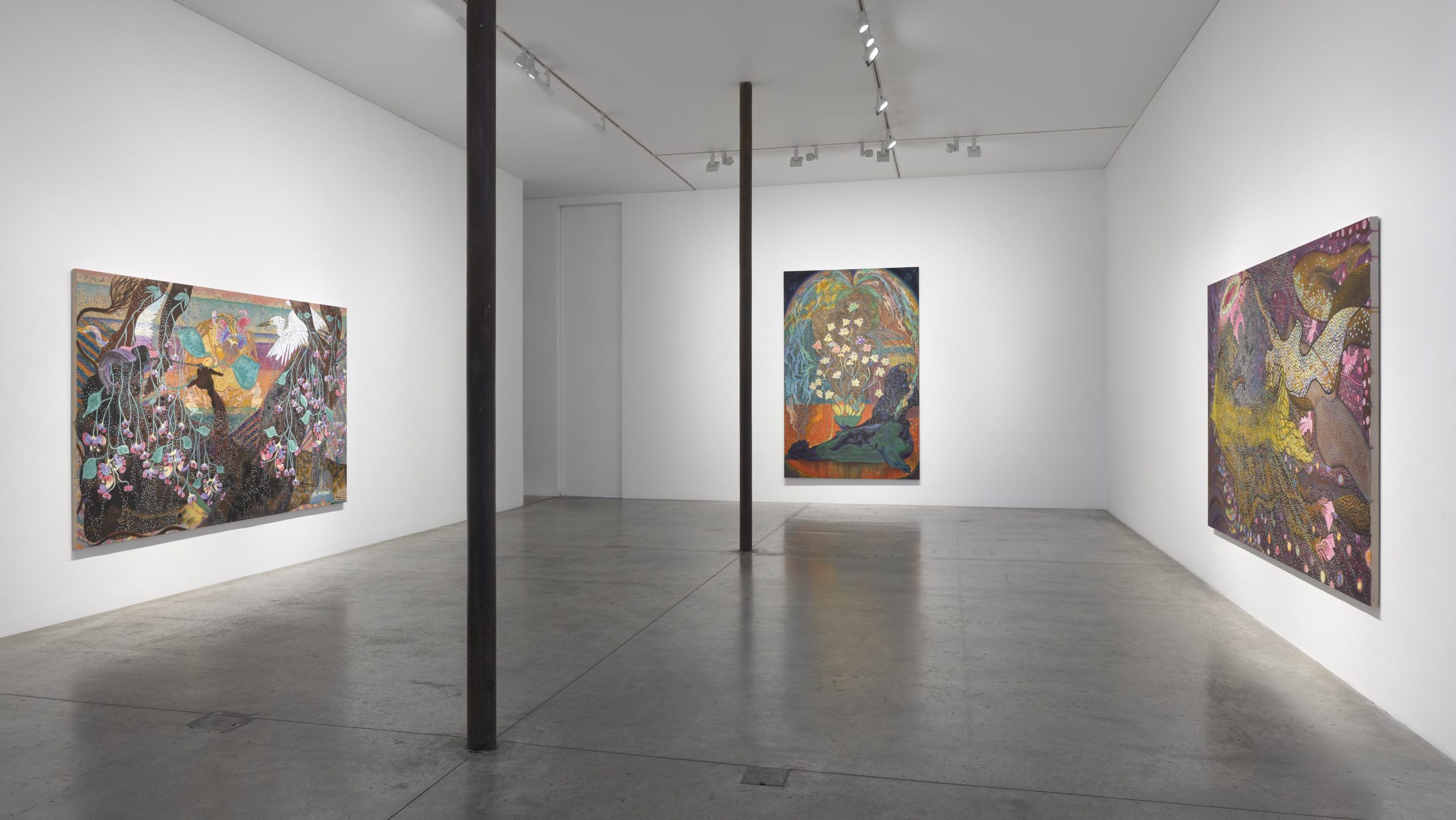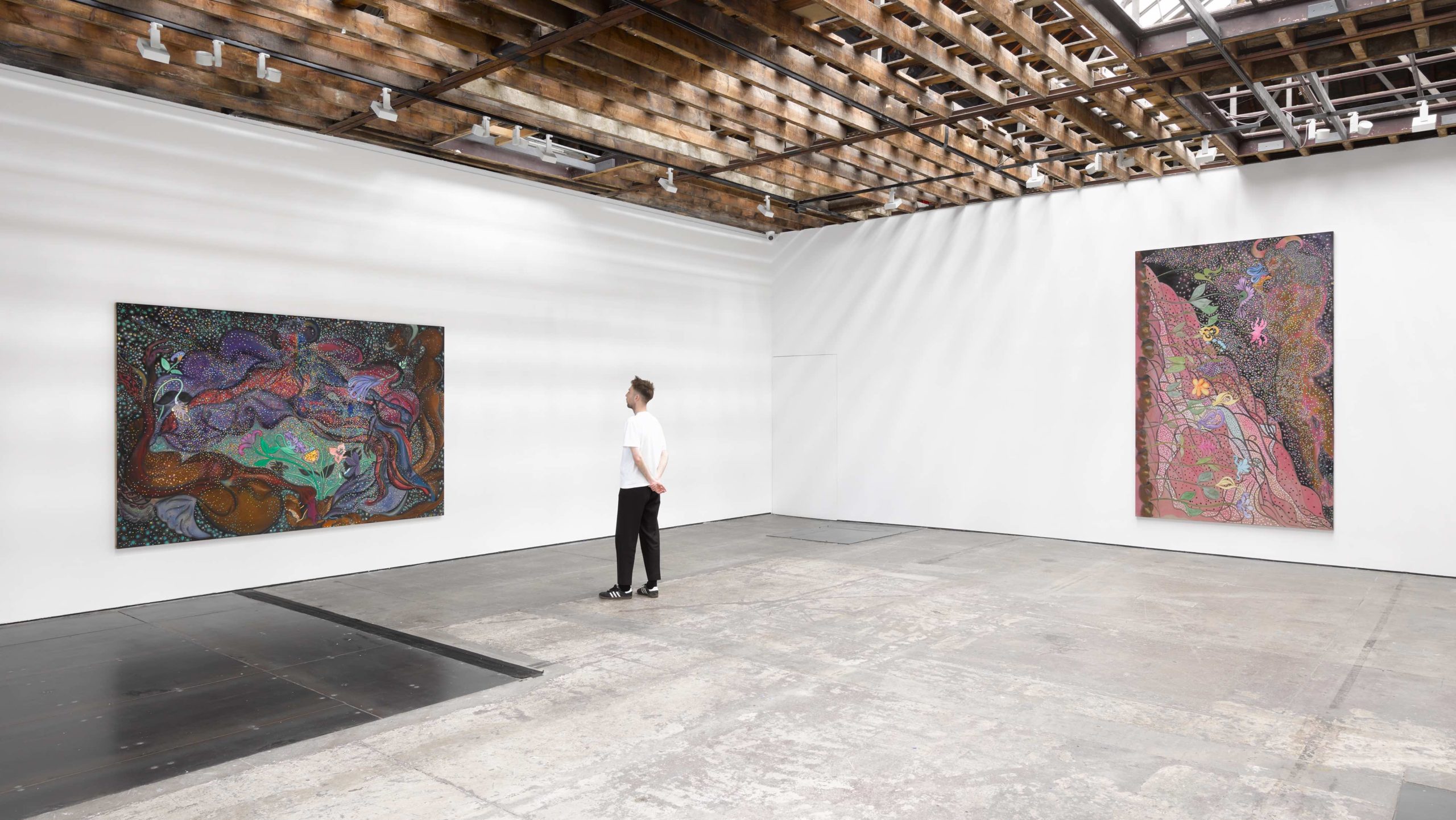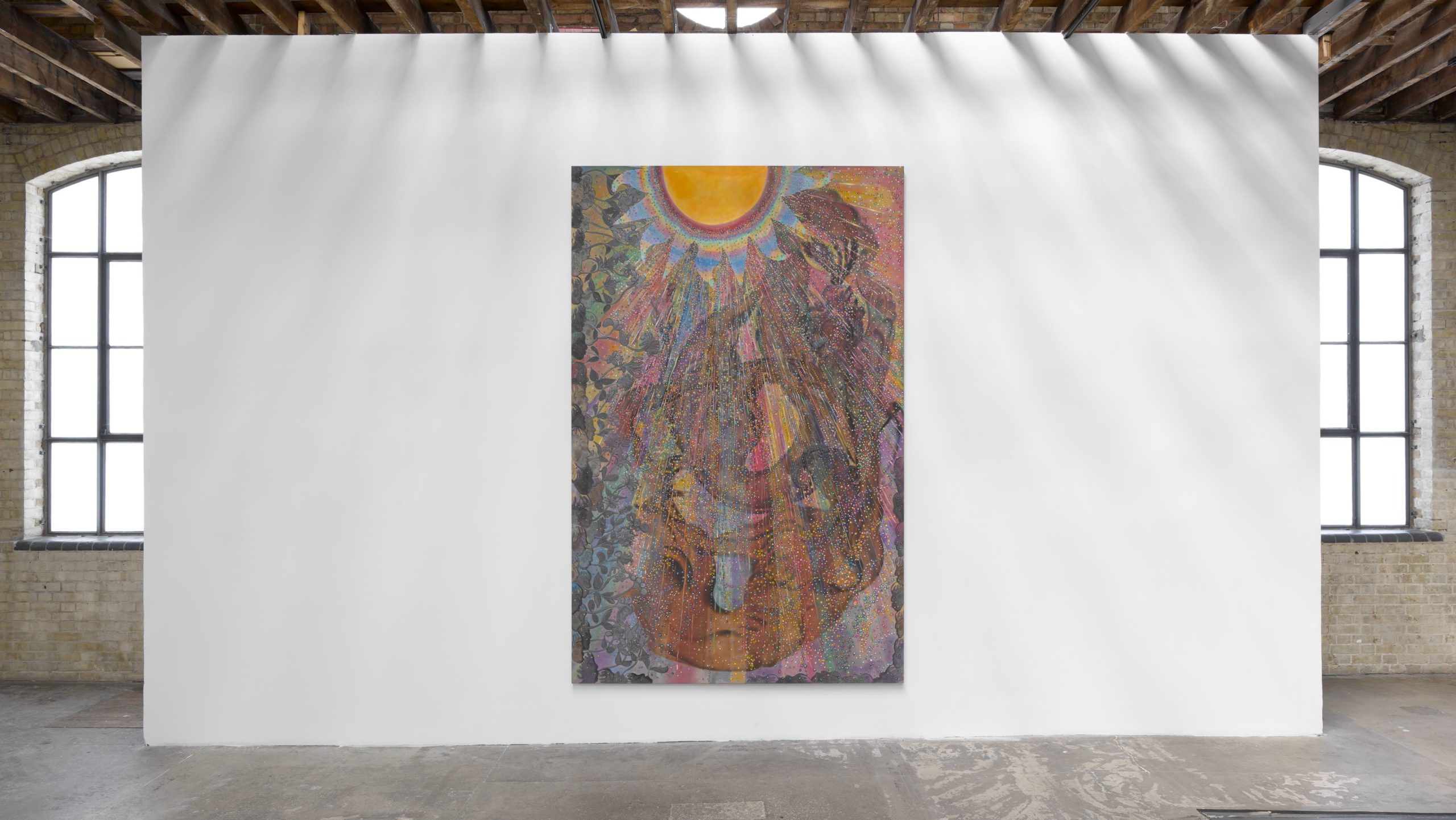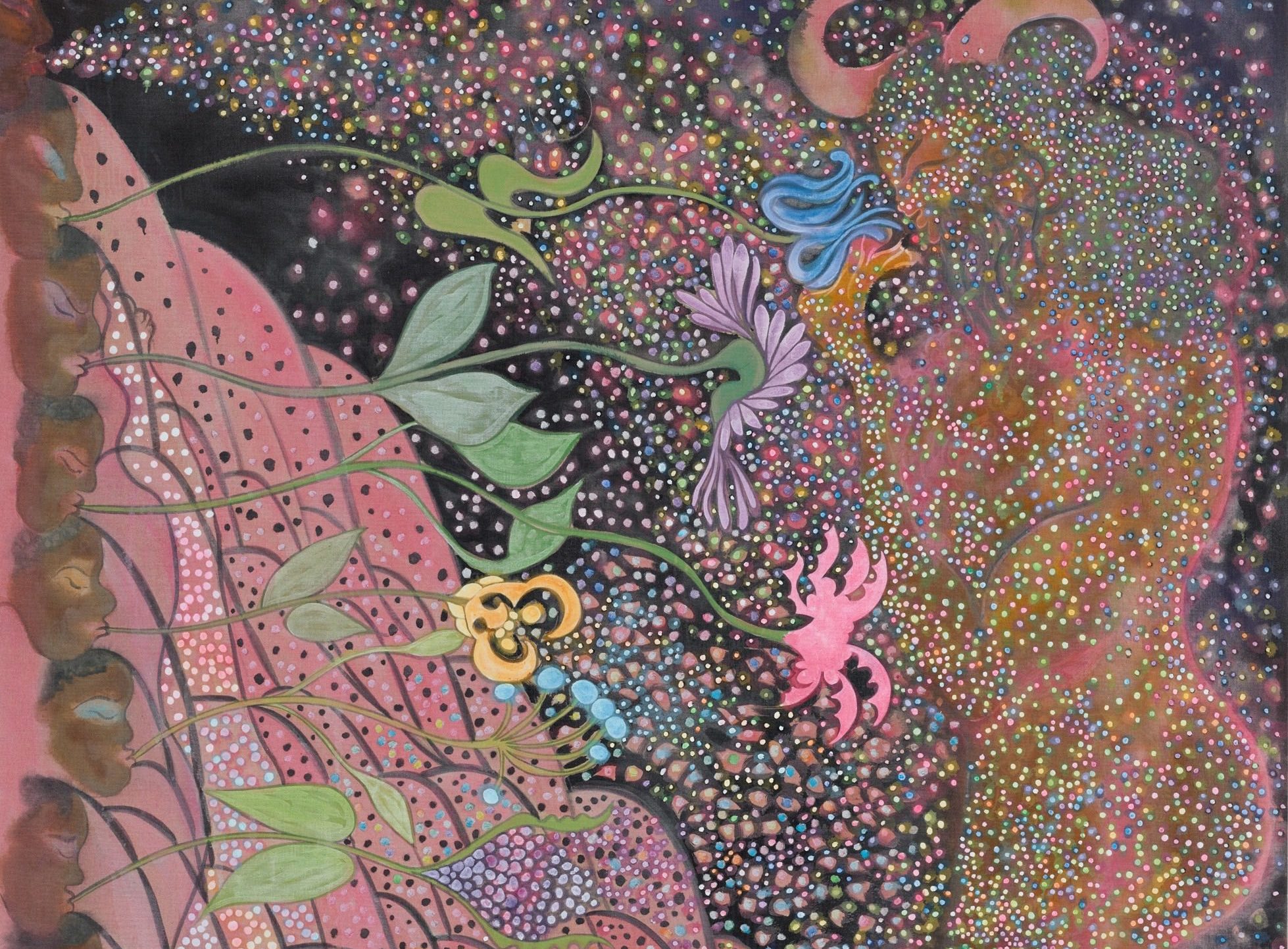
Chris Ofili: The Seven Deadly Sins
Exhibition 2 June–29 July 2023
Tuesday–Saturday: 10am–6pm
Special opening for London Gallery Weekend: Sunday 4 June: 10am–5pm
16 Wharf Road, London N1 7RW
The Seven Deadly Sins is a major new series of paintings by Chris Ofili. Completed over the past six years, the works offer an expansive meditation on sin and the complex experience of sinfulness.
In this series of works, Chris Ofili contemplates the seven deadly sins – a subject with Biblical origins that bears fundamentally on the human condition and human behaviour.
Accompanying the exhibition is a new publication: Ofili invited seven writers – Hilton Als, Inua Ellams, Marlon James, Anthony Joseph, Ayanna Lloyd Banwo, Attillah Springer and Lynette Yiadom-Boakye – to contribute new writing. Like Ofili’s paintings, their poems and narratives are not confined to illustrating single sins but meditate, personally and expansively, on the seven deadly sins.
Excerpts from the book feature below, along with commentaries about the paintings on view.
The artist, raised as a Roman Catholic, had long wanted to work through the themes and associations – personal and broad-ranging – that gather around sin. Aware that this significant project would require the devotion of a substantial and unbroken period of time, he couldn’t have foreseen that it would be the long intervals of enforced isolation accompanying the onset of the Covid pandemic which would occasion heightened reflection and introspection. Ofili has said of the resulting series of seven works, ‘It felt like the right subject: for the time and for these times.’
The artist intended each painting not to cleave to a particular sin, but to encompass a spectrum of excessive and transgressive behaviours. For Ofili, ‘There are seven days; each day is made of the same elements – the same hours – but each day turns out differently. Each work takes a slightly different approach, and one sin might become more dominant.’
Moving through dreamlike realms at once paradisiacal, other-worldly and cosmic, these works depict scenes where humans and mythological creatures co-exist. The natural world is fecund and mysterious in this territory of sinfulness, a place where magnetic forces of attraction and repulsion hold sway. It seems born of a liminal, trance-like state, perhaps between wake and sleep, when strange visions swim up into the mind’s eye from a creative, playful place in the unconscious that has little to do with the strictures of rationality.
If these paintings symbolise the mind’s innermost workings, then sin is almost a generating principle, catalysing internal dynamics of self-interrogation and self-knowledge. Although they are not simply autobiographical, Ofili found that their subject matter resonated with his formative religious education, and the impact on his psyche of ideas of right and wrong, guilt, innocence and confession. Here, sin and reflection go hand in hand: ‘I think the works are more about the inner feelings one has about the sin – not necessarily only in the moment of committal – than about what happens afterwards, or the idea of judgement.’
In these works the artist’s interrogations move beyond the straightforward dichotomies of good or bad, before and after; moral and temporal simultaneity are inextricably linked. Characters and events are suspended in a state of growth or motion as the artist seeks to expand the threshold of the moment – discrete instants becoming broad planes which can be inhabited and explored. As Ofili notes, ‘Time can be conceptualised as a sweeping hand, rather than a ticking hand – I’m trying to find a sweep of time, rather than the mechanical units of time.’
Also on view is Ofili’s Pink Daydreams of a Faun, a series of ten prints on unique Suminagashi paintings, inspired by Stéphane Mallarmé’s Symbolist poem L’Après-midi d’un faune, and printed and published in 29 suites by Two Palms, New York. Alongside the suite on view is a new book published by Victoria Miro, which includes Mallarmé’s poem and an essay by Minna Moore Ede, who traces its legacy across works by Debussy, Manet, Nijinsky and others, and considers its influence as a generative impulse in Ofili’s work.
Image above: The Pink Waterfall (detail), 2019–2023
The Fountain
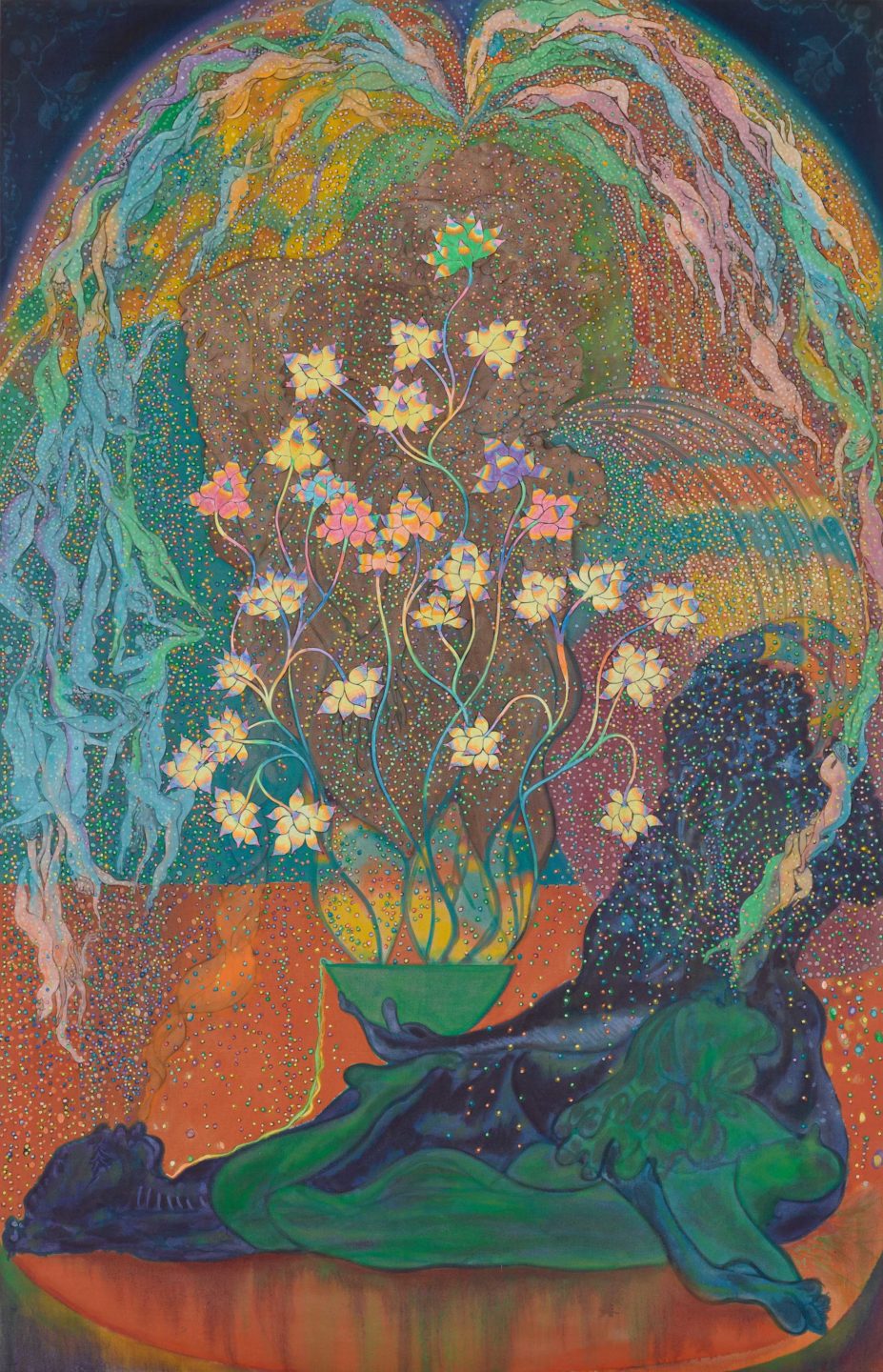
310 x 200 cm
122 x 78 3/4 in
Oil and charcoal on linen
Chris Ofili, The Fountain, 2017–2023
More info‘I think the works are more about the inner feelings one has about the sin – not necessarily only in the moment of committal – than about what happens afterwards, or the idea of judgement.’ — Chris Ofili
Gathered around the base of a deep bowl, three figures are focused on supporting the vessel and the burst of fire, flowers, and particles that spring up from it. A plume of smoke rises and simultaneously reveals itself as a tangle of figures. They reach upwards, opening their mouths to become the source of a cascading stream of smaller spectral figures jetting up – some seem to disperse and some are drawn back down towards the bowl. There is a feeling of symbiosis within this painting, with elements feeding each other in a cyclical motion.
Quote 2 Hilton Als
‘In real life, our sins are often as unclear as our nicer motivations; often they’re jumbled together, a ball of spores that shoot off in all directions whenever another human, or life event, enters our consciousness, and heart.’ — Hilton Als
The Harvester
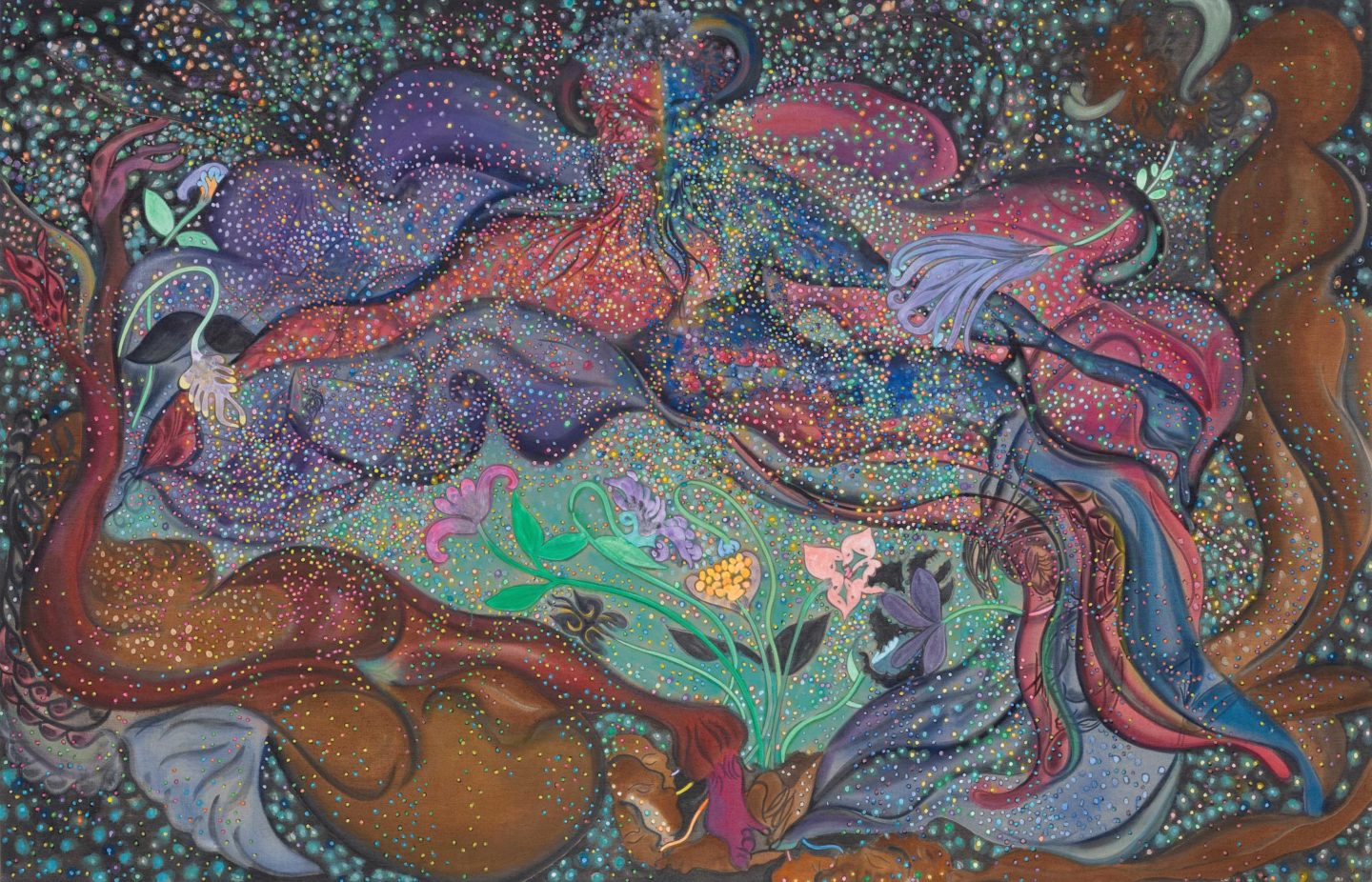
200 x 310 cm
78 3/4 x 122 in
Oil and charcoal on linen
Chris Ofili, The Harvester, 2019–2023
More infoThis painting is dominated by a figure that recurs in Ofili’s work, and which he refers to as the ‘Harvester’. Here, he presides over a zone populated by an explosion of glowing, spore-like forms, redolent of creative or transitional energies. Exotic flowers sprout from the mouths of the faces at the bottom of the work, creating their own fertile atmosphere in this cauldron of activity. Flowers are also borne by the three further figures: most prominently, a satyr, bowing his head, tenders from his lips a languid purple bloom that resembles a paintbrush.
Quote 5 Inua Ellams
‘Greed, like lust and gluttony, is a sin of desire. However, this desire is to acquire more than one needs.’ — Inua Ellams
The Swing
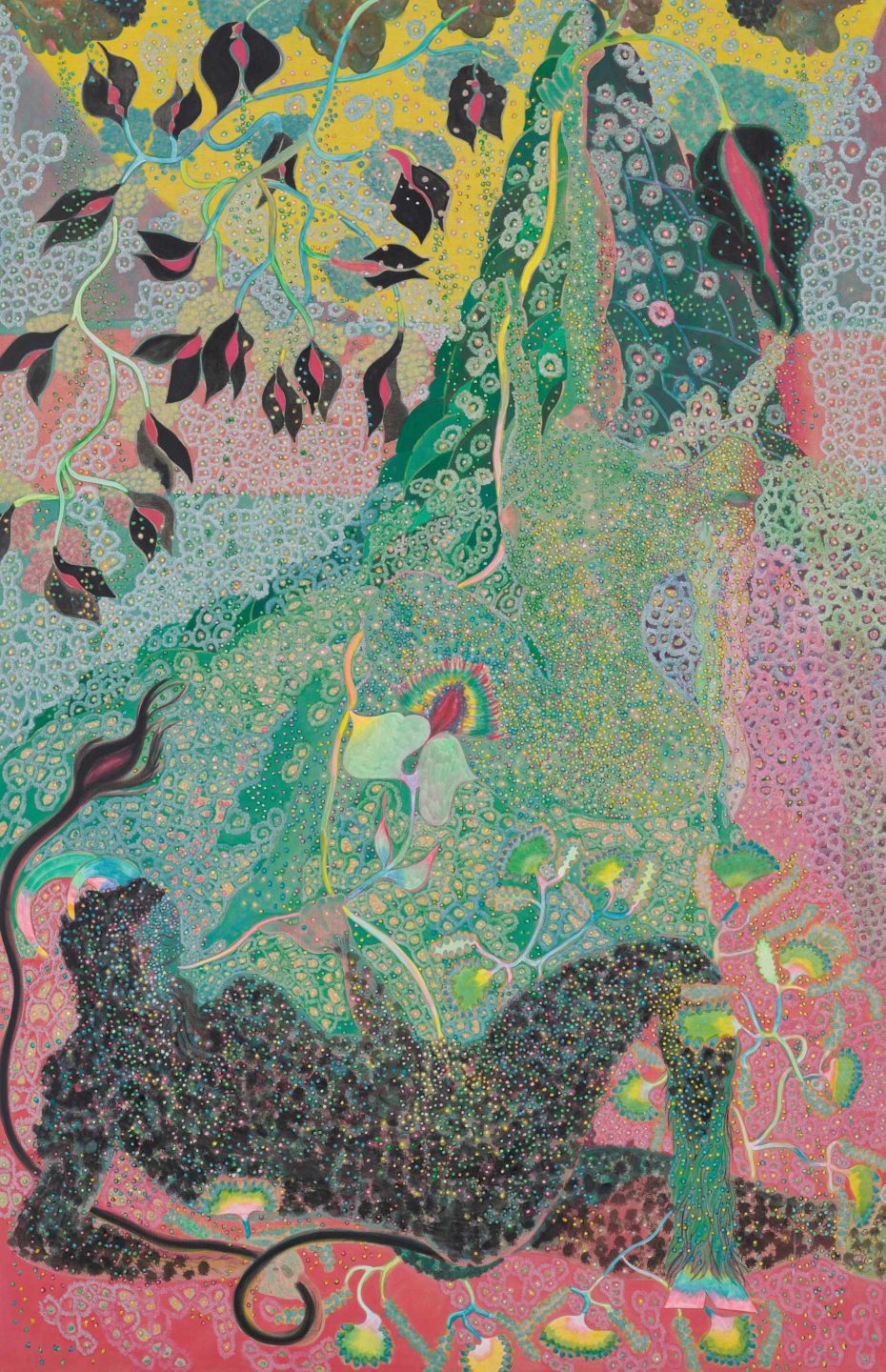
310 x 200 cm
122 x 78 3/4 in
Oil and charcoal on linen
Chris Ofili, The Swing, 2020–2023
More infoAlthough the time of day is uncertain, this painting is saturated by summertime fertility. A female figure swings in an attitude of lazy abandon, while a satyr lounges in the pink foreground. Partly inspired by Mallarmé’s symbolist poem The Afternoon of a Faun, in which the central character reflects on his visions of a pair of nymphs, these two figures aren’t necessarily of the same spatio-temporal plane. While the satyr is earth-bound, connected to the flowers that his looping tail resembles, the vaporous nymph almost dissolves into and out of the air through which she moves.
Quote 7 Marlon James
‘Sometimes I think sin is merely a good thing taken too far. Sloth is relaxation if black people relaxed like white people.’ — Marlon James
The Crowning
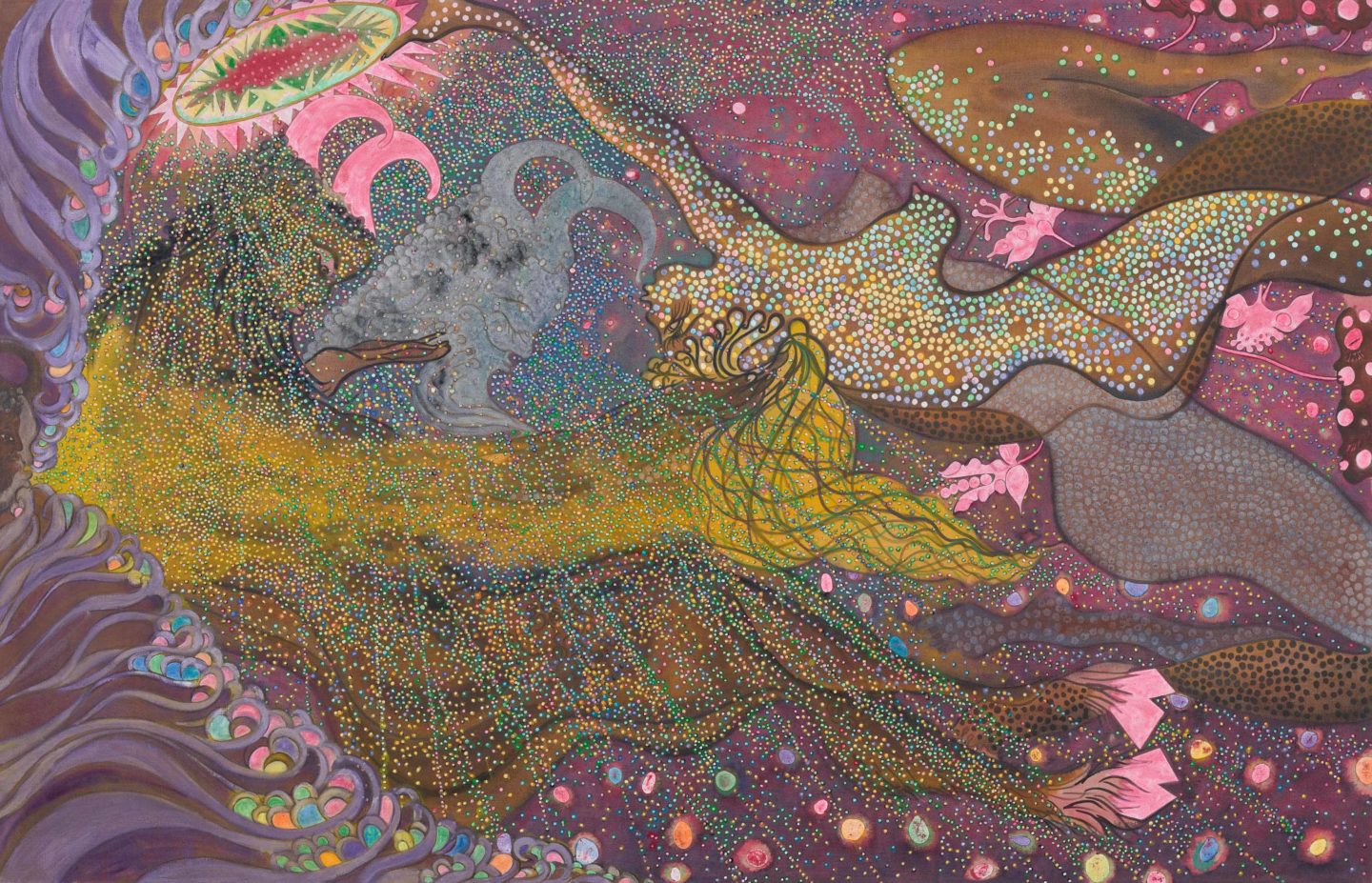
200 x 310 cm
78 3/4 x 122 in
Oil and charcoal on linen
Chris Ofili, The Crowning, 2021–2023
More info‘Time can be conceptualised as a sweeping hand, rather than a ticking hand – I’m trying to find a sweep of time, rather than the mechanical units of time.’ — Chris Ofili
A satyr with glowing pink horns reclines and bows his head, his upturned palm outstretched before him. From his hand, he presents a shadowy double of his own head. He appears to remove a mask or shed a skin, suggesting he is offering some part of himself – an essence or soul. Placing a crown on the satyr with an extended arm, a female figure bends backwards, her multi-limbed form suggesting she is caught in the various stages of movement. In the shadowing and echoing of forms, a palimpsest of earlier moments seems to permeate the present.
Quote 6 Anthony Joseph
‘I am maudlin and thin with envious sin
for a dream in which a hairy snake
is cornered in a drum – all hiss
and no teeth.’
— Anthony Joseph
The Fall From Grace
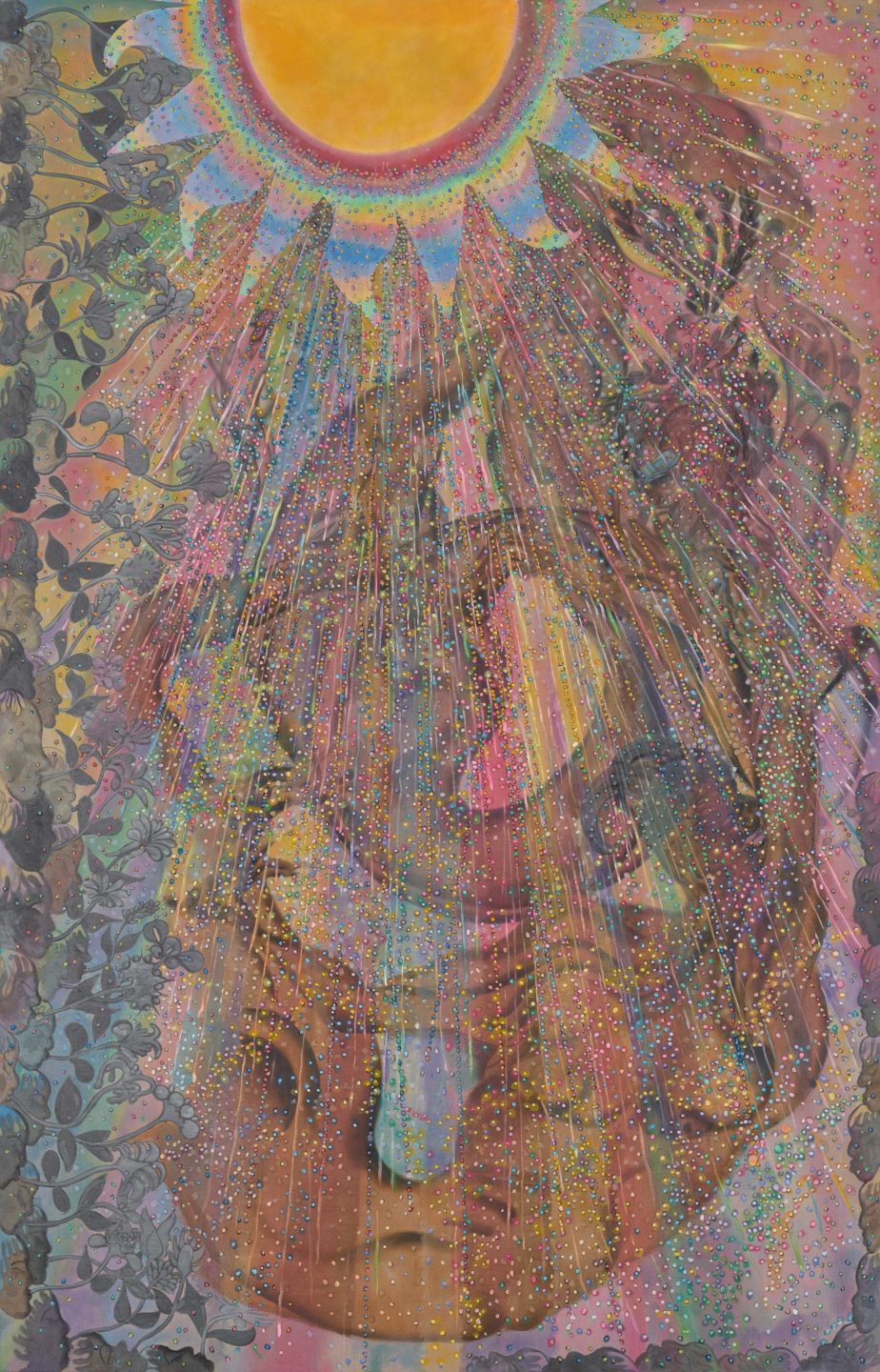
310 x 200 cm
122 x 78 3/4 in
Oil and charcoal on linen
Chris Ofili, The Fall From Grace, 2019–2023
More infoA bright yolk-like sunburst dominates this painting, its beams casting prismatic striations down and across the entirety of the image. The sun rays catch the image of two falling figures, evoking the tale of Icarus in which, in an act of hubris, he flew too close to the sun, causing his feather and wax wings to melt and sending him to his death in the sea below. In his nod to Icarus at the very moment of transgression, Ofili foregrounds his exploration of the liminality of sin and the crossing of boundaries just as an act is being committed.
Quote 1 Ayanna Lloyd Banwo
‘The hearts of children,’ Sir bellowed, his hand gripping the black book, ‘small as they may be, are the perfect vessels for sin.’ — Ayanna Lloyd Banwo
The Great Beauty
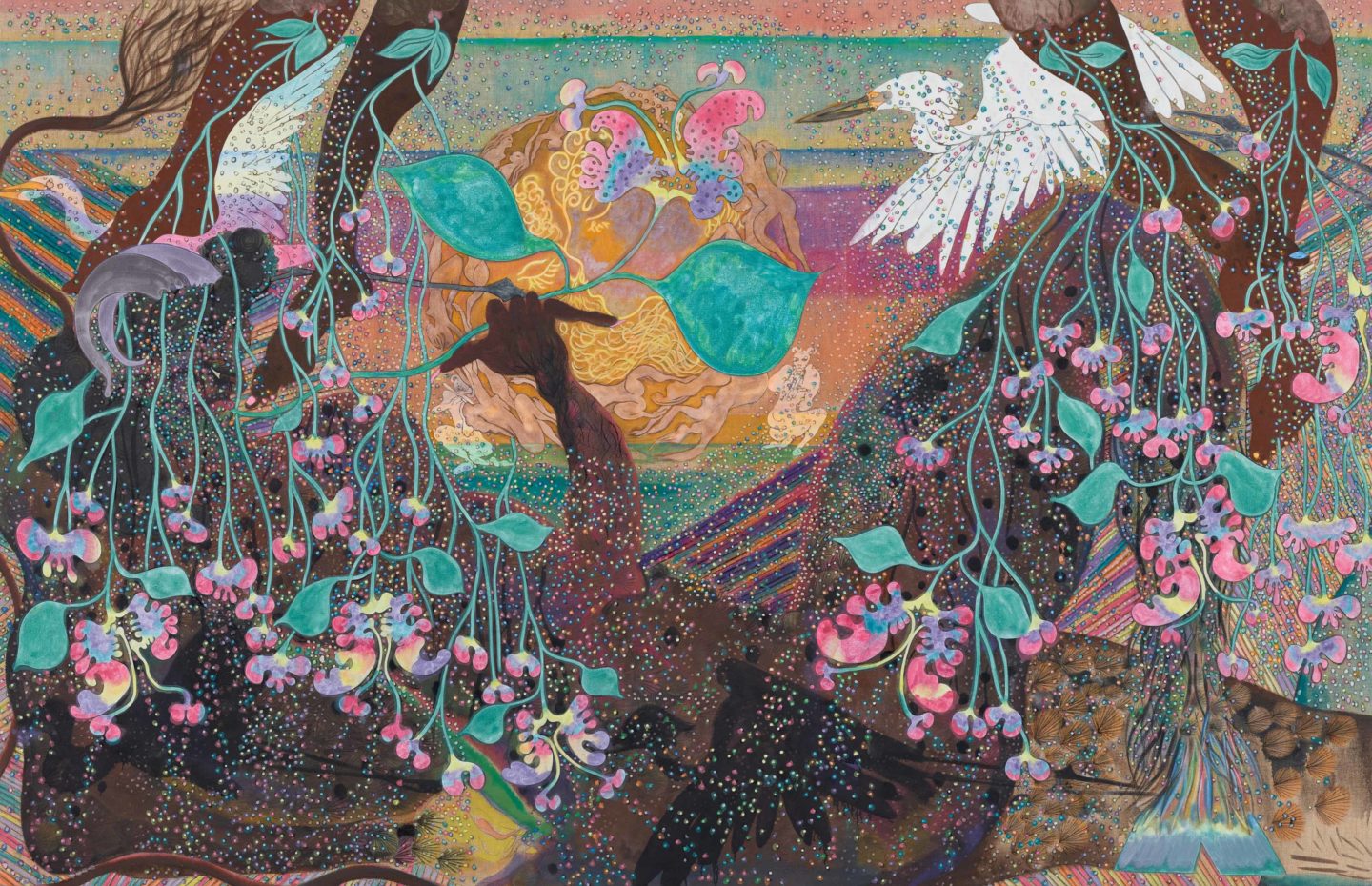
200 x 310 cm
78 3/4 x 122 in
Oil and charcoal on linen
Chris Ofili, The Great Beauty, 2020–2023
More infoThe satyr depicted here reclines voluptuously, as if supported by the edges of the canvas that offers a window on to his world. As the sun sets in this paradisiacal, yet tantalisingly earthly place, a pair of egrets glides overhead. Dangling from the top of the painting are two pairs of legs and feet. Perhaps these are fragments of memory, or fugitive figures descending through the scene. Is the satyr unknowingly observed, or has he summoned (or banished) two of his companions?
Quote 4 Attillah Springer
‘Mummy, what is Sin?
Sin is something that powerful people do, for which powerless people have to pay the price.’ — Attillah Springer
The Pink Waterfall
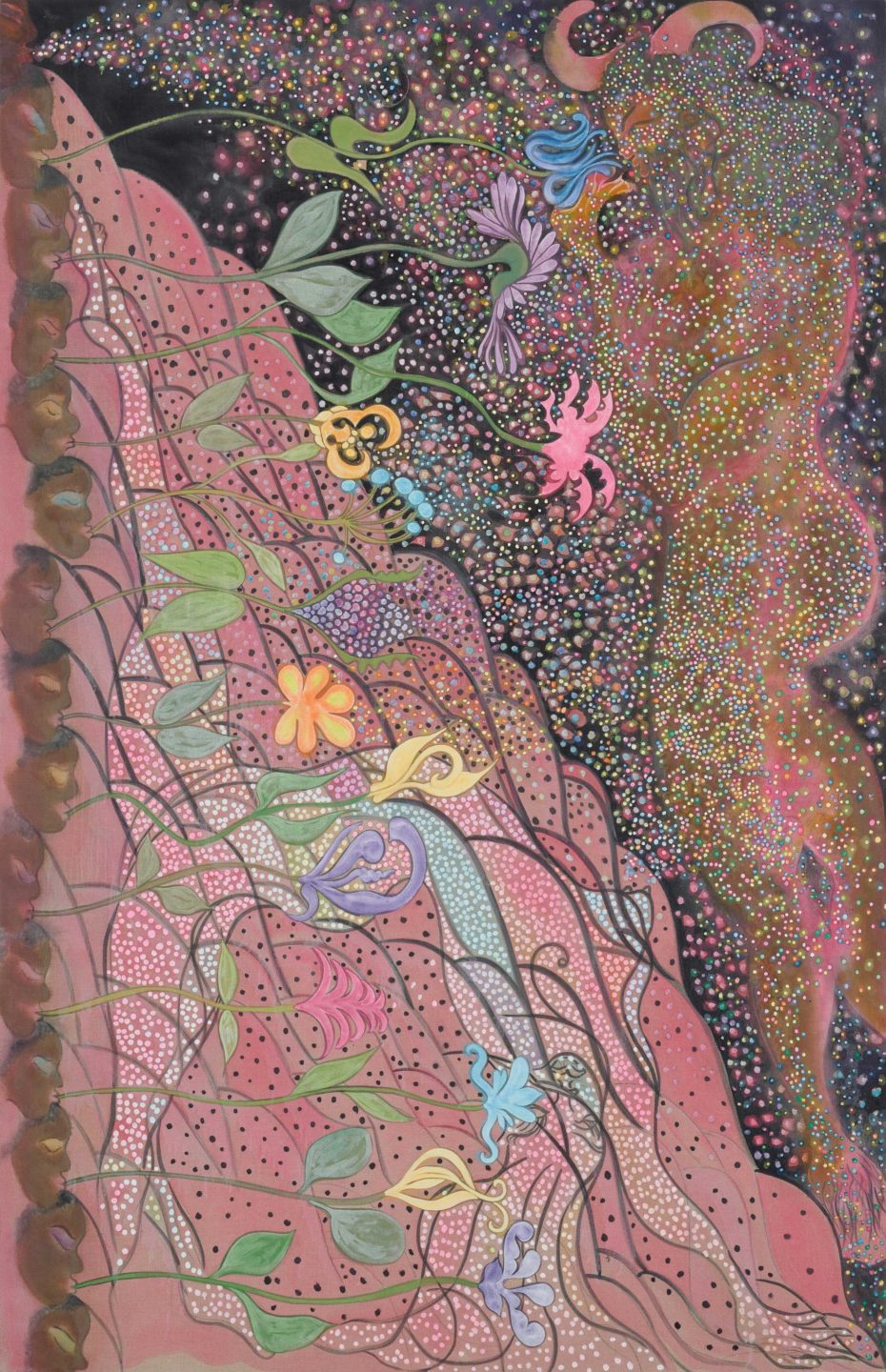
310 x 200 cm
122 x 78 3/4 in
Oil and charcoal on linen
Chris Ofili, The Pink Waterfall, 2019–2023
More infoA tumbling pink waterfall envelops an arcing female figure. Submerged beneath the water, she stretches backwards with one leg extended straight up above her. Stacked along the left edge of the canvas, a tower of faces in profile hold between their lips the stems of plants which sprout across the work, culminating in bright exotic blooms. The first face in profile at the top left corner sprays a fountain of particles from their mouth, which vibrate and shimmer across the picture plane. The spray coalesces in clusters to reveal the figure of a satyr, formed by the particles in the atmosphere against the inky night sky behind him. The satyr smells the flowers growing towards him and appears to be in deep contemplation, either in a reverie from their scent or preparing to consume them.
Quote 3 Lynette Yiadom-Boakye
‘Sin can fill your mouth, and belly and loins but not your heart!’ The Rooster addressed the Peahens. ‘Sisters, turn from sin and save yourselves!’ — Lynette Yiadom-Boakye
The Seven Deadly Sins publication
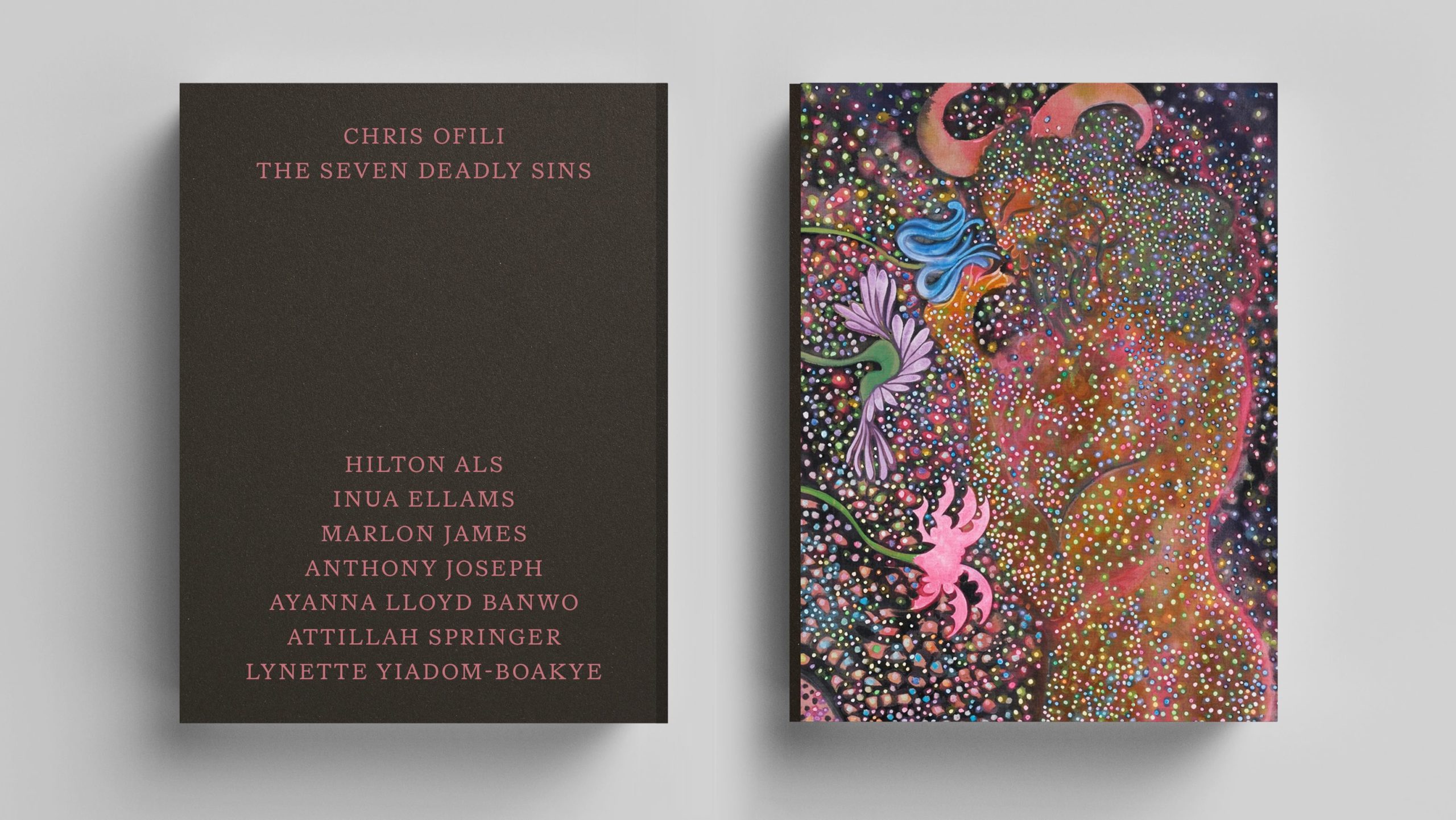
This exquisitely produced book is published by Victoria Miro on the occasion of the exhibition. Chris Ofili invited seven writers – Hilton Als, Inua Ellams, Marlon James, Anthony Joseph, Ayanna Lloyd Banwo, Attillah Springer and Lynette Yiadom-Boakye – to contribute new writing. Like Ofili’s paintings, their poems and narratives are not confined to illustrating single sins but meditate, personally and expansively, on sinfulness.
222 x 280 mm, 66 page hardback book with three-piece binding and foil blocked on back cover, illustrated with 7 paintings, 7 details.
Designed by Atelier Dyakova and printed and bound by Roy Killen.
ISBN 978–1–914506–07–9
Also on view – Pink Daydreams of a Faun
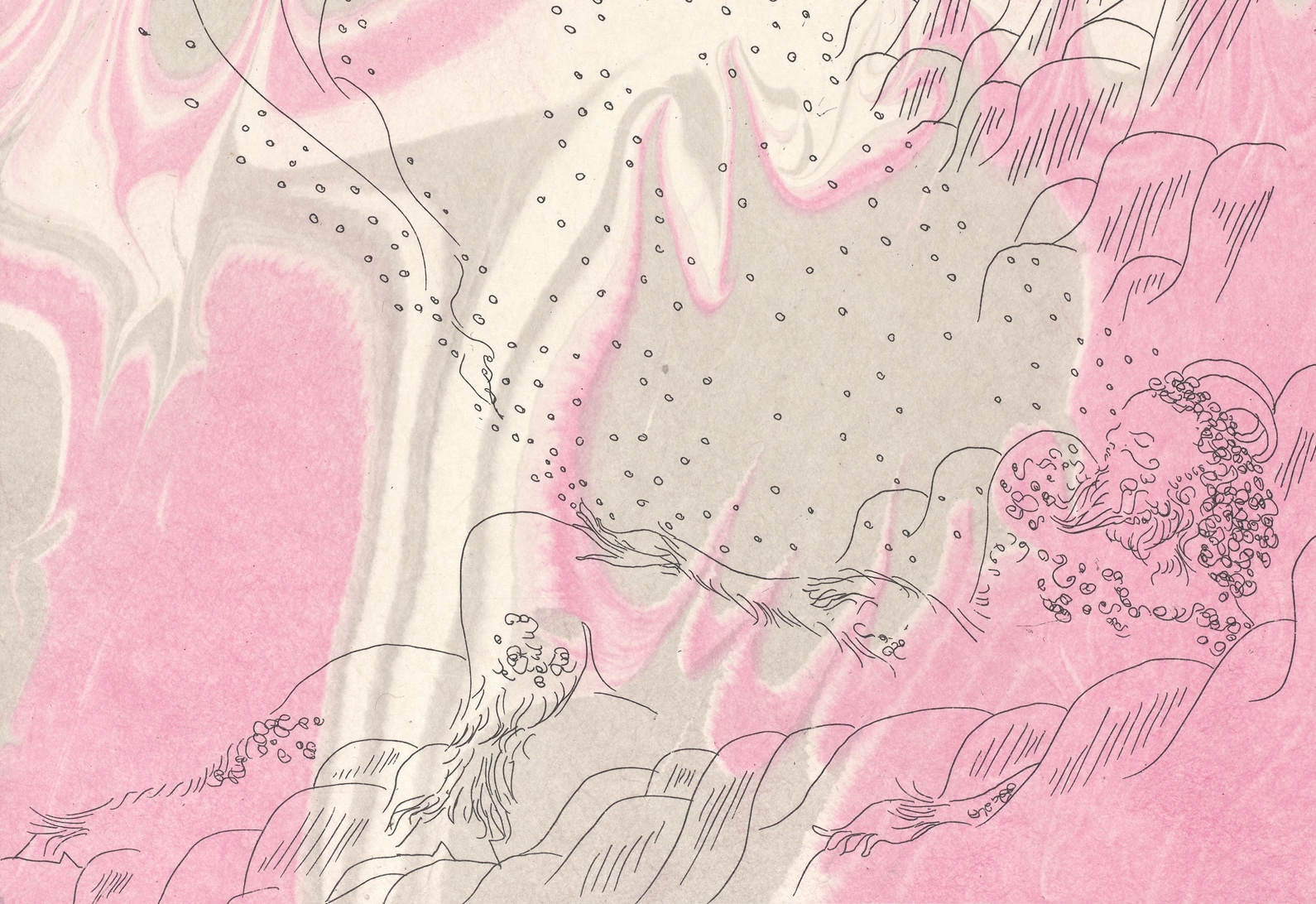
Chris Ofili’s Pink Daydreams of a Faun is a series of ten prints on unique Suminagashi paintings, inspired by Stéphane Mallarmé’s Symbolist poem L’Après-midi d’un faune, and printed and published in 29 suites by Two Palms, New York. Alongside the suite on view is a new book published by Victoria Miro, which includes Mallarmé’s poem and an essay by Minna Moore Ede, who traces its legacy across works by Debussy, Manet, Nijinsky and others, and considers its influence as a generative impulse in Ofili’s work.
About the artist
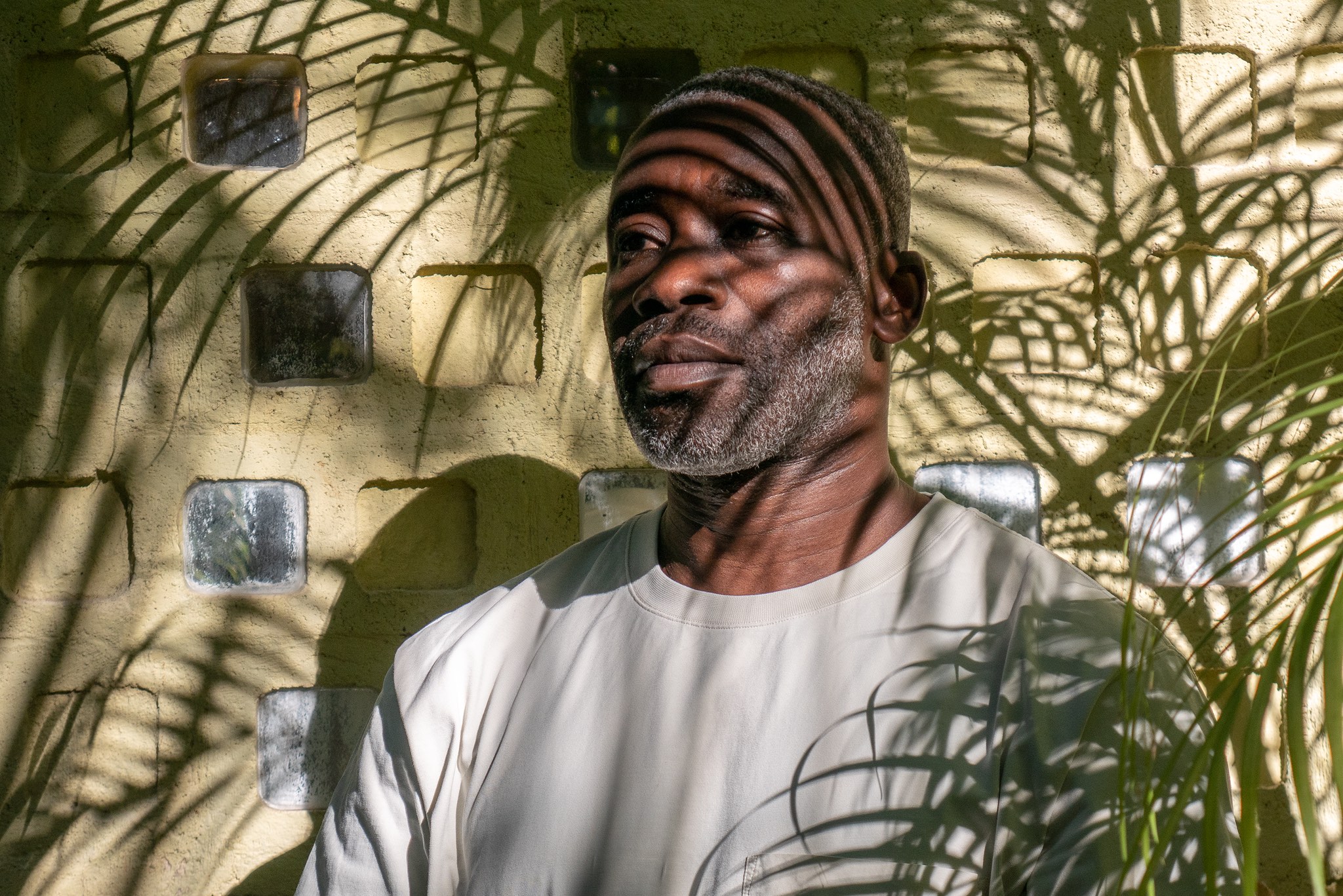
Chris Ofili was born in Manchester, England, in 1968, and currently lives and works in Trinidad. Major solo exhibitions of the artist’s work have been presented at international venues including the Institute of Contemporary Art, Miami (2017–2019); National Gallery, London (2017); New Museum, New York (2014–2015), travelling to Aspen Art Museum (2015); The Arts Club of Chicago (2010); Tate Britain, London (2010 and 2005); Kestner Gesellschaft, Hannover (2006), The Studio Museum in Harlem, New York (2005), and Serpentine Gallery, London (1998). The artist represented Britain in the 50th Venice Biennale in 2003 and won the Turner Prize in 1998.
